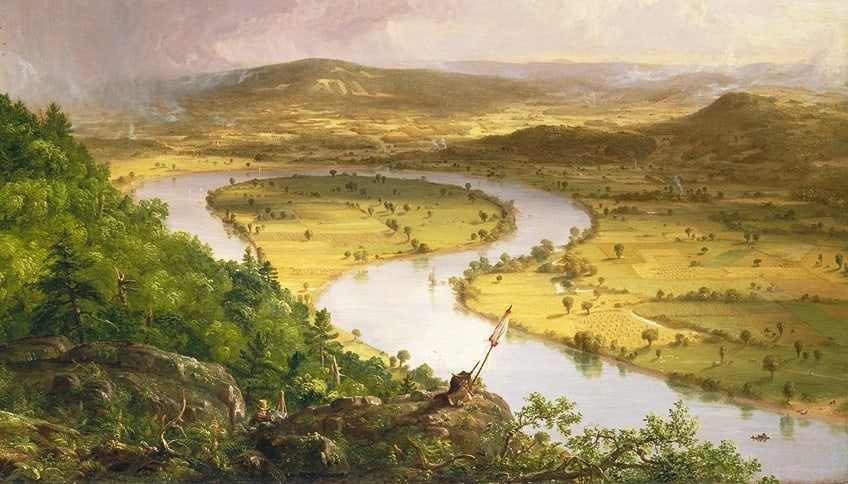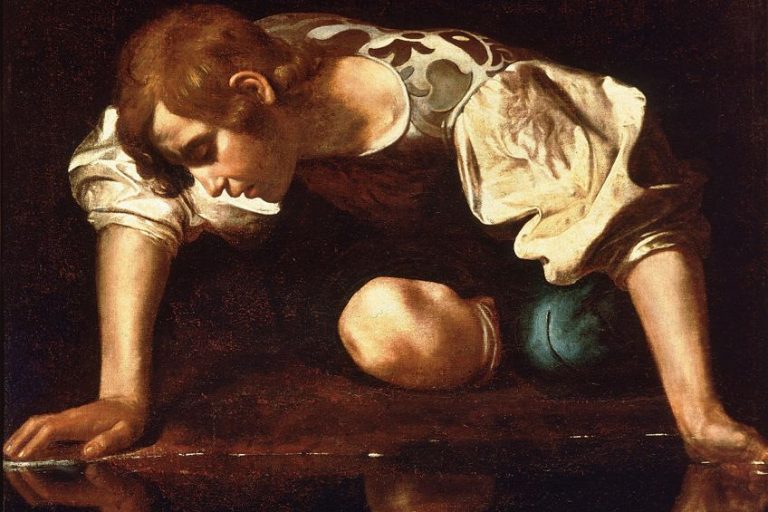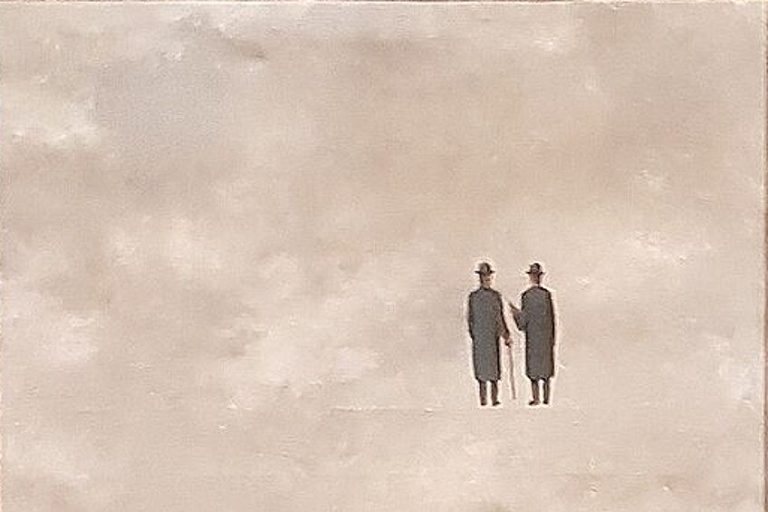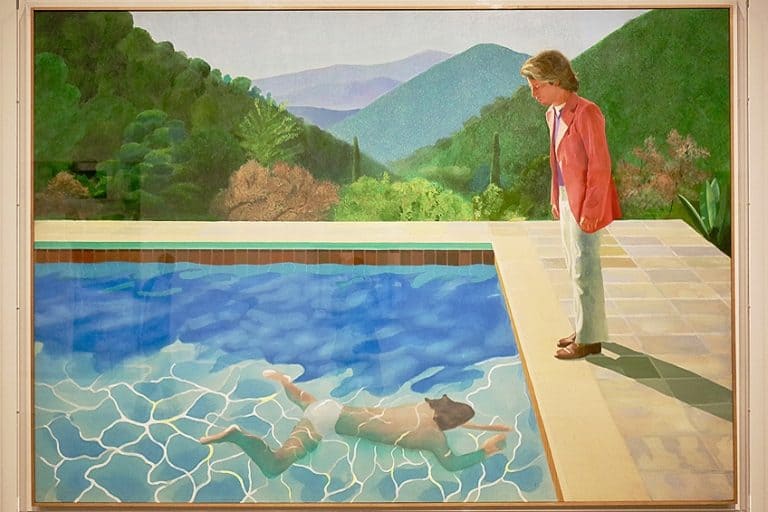“The Oxbow” by Thomas Cole – A Look at “The Oxbow” Painting
Thomas Cole was one of the leading landscape painters in America. The Oxbow painting from 1836 is just one example of how the artist captured the magnificence of the North American landscape while touching on ideas of civilization, development, and the wilderness. Below we will discuss the artwork in more detail.
Artist Abstract: Who Was Thomas Cole?
Thomas Cole was born in Lancashire, England on February 1, 1801, and died in Catskill, New York on February 11, 1848. In 1818 his family moved to the United States. He also traveled and lived abroad in Italy for several years.
He was known as the founder of The Hudson River School and encapsulated the North American landscape in his paintings.

He loved the wilderness and nature and was believed to hold reservations about urbanization and the destruction of the natural landscape. Some of his artworks include Lake with Dead Trees (1825), The Last of the Mohicans: The Death of Cora (c.1827), and The Titan’s Goblet (1833).
The Oxbow (1836) by Thomas Cole in Context
| Artist | Thomas Cole |
| Date Painted | 1836 |
| Medium | Oil on canvas |
| Genre | Landscape painting |
| Period/Movement | Romanticism |
| Dimensions (cm) | 130.8 x 193 |
| Series/Versions | N/A |
| Where Is It Housed? | Metropolitan Museum of Art, New York City, United States |
| What It Is Worth | Purchased for $500 in 1836 by Charles Nicoll Talbot, and donated to the Metropolitan Museum of Art by Olivia Sage in 1908. |
The Oxbow painting by Thomas Cole is also titled as View from Mount Holyoke, Northampton, Massachusetts, After a Thunderstorm. This article will discuss a contextual analysis of when Cole painted it and a formal analysis of the visual composition.
Contextual Analysis: A Brief Socio-Historical Overview
Thomas Cole was known for his landscape paintings titled The Course of Empire (1833 to 1836). These were commissioned by Lumen Reed, who was a patron of the arts and a significant businessman in America. This series of paintings explored the cyclical nature of how an empire rises and falls.
The idea of the wilderness was a large part of the final painting titled “Desolation” (1836) because it has taken over what was a man-made, notably Western, civilization.
Cole’s Respite From Painting
This idea of nature versus civilization is what Cole explored in The Oxbow painting too, which was during the time of his final painting of the series mentioned above, in 1836. However, at Reed’s suggestion, Cole painted The Oxbow to be shown at the annual exhibition of the National Academy of Design, in April 1836. Reportedly, Cole experienced a bout of depression during his process of painting The Course of Empire, and Reed proposed that he paint something more suited to his painting style that would be exhibited in April, which would also be up for sale. This offered Cole a respite from painting the series.
According to Cole’s letter in reply to Reed, the artist was hesitant to start something new because of his patron’s generosity, but he accepted the proposition and suggested painting Mount Holyoke.
He described it as “well-known” and reportedly already had an image of it in his sketchbook as the “finest scene”, and that it will be “novel” and “effective”. Furthermore, Cole also described in his letter that he could not find a “subject” that was close in resemblance to the second iteration of Reed’s series, titled The Arcadian or Pastoral State (1834) because Reed suggested an image that was like it.

The Oxbow painting was believed to have been inspired when Cole saw the image of the landscape in Basil Hall’s (who was known as a British author and traveler) publication titled “Forty Etchings Made with the Camera Lucida in North America in 1827 and 1828” (1829), which was when Cole visited London around the years 1829 to 1832.
It is believed that Cole traced Hall’s etchings and found the idea for “The Oxbow” painting from his sketches. Other theories suggest that Cole could have visited the location of the river and landscape itself in America.
The Oxbow painting was reportedly sold at the 1836 exhibition to Charles Nicoll Talbot, who purchased it for $500. The painting made its way through various exhibitions and was eventually purchased by the known philanthropist Olivia Sage who donated it to the Metropolitan Museum of Art in 1908. It is unclear how much Olivia Sage purchased The Oxbow painting for.
Formal Analysis: A Brief Compositional Overview
In the formal analysis of The Oxbow painting a visual description will explore the pictorial details of this oil on canvas including how the main art elements compose it, namely its color, texture, line, shape, form, and how the artist conveyed and utilized space. These will provide a deeper understanding of how the elements of art can be utilized in a variety of techniques to compose an artwork.

Subject Matter: Visual Description
The Oxbow by Thomas Cole measures 130.8 x 193 centimeters and depicts a vast landscape view from Mount Holyoke in Massachusetts, in fact, the full title of the painting is View from Mount Holyoke, Northampton, Massachusetts, After a Thunderstorm. The upper third of the composition consists of a darkened stormy sky brewing in the top left corner, which gradually opens to a blue sky towards the right of the composition and overlooks a vast green landscape.
The lower left side of the composition depicts the uppermost parts of Mount Holyoke, which depicts a tree in the corner with its craggy trunk and roots among several rocks. Behind the tree are green bushes and shrubbery, which is often described as the “wilderness”, that overlooks the rest of the landscape to the right.
The landscape below this cliff face depicts the bend of the Connecticut River and a vastly open plain with hills and trees. This area also depicts patches of logging and more areas touched by human development, which is often described in terms of being the side touched by “civilization”.

Along the lower part of the composition, perched in between the bushes on the cliff side, is a self-portrait of the artist, Thomas Cole. He appears to be seated in front of an easel and busy painting, undoubtedly the landscape in front of him.
He is looking at us, the viewers, as if we have stepped into the space and caught his attention.
Another interesting observation in The Oxbow painting includes what is termed “logging scars” on the slightly off-center hillside in the distant background. These are reportedly in the form of Hebrew lettering that spell out the words “Noah” (נח) and “Shaddai”. The latter word is reportedly viewed and read upside down and what would be read from God’s perspective.
Color
Thomas Cole utilized a natural color scheme in The Oxbow painting, from the brighter greens of the bushes in the foreground, the browns of the tree, the more yellow greens of the landscape, and the blues and grays of the sky and rain clouds.
A light source is indicated and implied, which is conveyed by the lighter and darker greens of the bushes in the foreground, for example, the storm clouds create a darker patch, and the clearing clouds reveal more light.
Texture
The Oxbow painting has implied texture, which conveys the naturalism and realism of the surrounding landscape. This is conveyed through other art elements like color and value, which creates different effects, for example, the bark of the tree in the foreground. Finer, wispier, brushstrokes create the idea of rain and dark storm clouds in the top right of the composition.

Line
There are strong implied lines utilized in The Oxbow by Thomas Cole, notably the leaning tree to the left, which creates a diagonal linearity. The vertical lines from the rain in the sky in the background create a sense of movement as they appear directed downwards toward the landscape.
The bend of the river creates curved lines, which contrasts with the straighter lines previously mentioned.
Additionally, the composition has also been described as divided into halves, noticeable by the distinct diagonal line running from the top left side to the bottom right side, or vice versa. This division also provides clues to the apparent division between nature and civilization.
Shape and Form
Thomas Cole’s The Oxbow painting consists of organic, naturalistic, shapes and forms. From the circular shape of the river bend to the more irregular shapes of the foliage, the tree, roots, and rocks in the left foreground, all contribute to the overall naturalism of the scene based on real life.

However, although there is an overall naturalism in the subject matter, there is also a slight contrast created by the irregularity of the organic shapes and forms compared to the more structured shapes and forms to the right. This can also hint at the symbolism of the wilderness versus civilization as mentioned above.
Space
The Oxbow painting by Thomas Cole depicts a vast open spatial composition and one that is seen from an aerial viewpoint, looking from above to below, with a slight angle from the left side. The horizon line is visible in the distance with a large expanse of sky.
This is ever so slightly blurred in detail through art elements like coloring and value to create a sense of depth.
The latter is further created by overlapping the foliage and tree in the foreground with the landscape below and behind it and depicting the scale of the trees in the landscape in a smaller size compared to what we, the viewers, see in the foreground.
A Tale of Two Landscapes
In Thomas Cole’s letter to Reed about The Oxbow painting, he mentioned that he wanted to “tell a tale”, and undoubtedly this tale is visually told. It is a tale of two landscapes, so to say, one that reminds us about the wildness of nature and one that shows us how nature can be “tamed”, but equally, how it can be the ultimate destructive force.

This article explored and discussed Thomas Cole’s “The Oxbow” painting and how this has been one of the leading landscape paintings exalting North America. This painting has been, and still is, a beautiful rendering of the American landscape.
Frequently Asked Questions
Who Painted The Oxbow Painting?
The Oxbow (1836) was painted by Thomas Cole, who was known as the founder of the American Hudson River School. He was one of the pioneering Romantic landscape painters of North America in the 19th century.
Where Is The Oxbow Painting Located?
The oil on canvas artwork, The Oxbow (1836), by Thomas Cole is housed at the Metropolitan Museum of Art in New York City. Charles Nicoll Talbot bought the painting for $500 in 1836 when it was exhibited, and Olivia Sage donated it to the museum in 1908 after she acquired it, of which the exact date is unclear.
What Does The Oxbow by Thomas Cole Symbolize?
The Oxbow, also titled View from Mount Holyoke, Northampton, Massachusetts, After a Thunderstorm (1836), painting by Thomas Cole is a representation of so-called pastoral settlement and the wilderness. It also holds a double meaning in terms of urban development and the beauty of nature.
Alicia du Plessis is a multidisciplinary writer. She completed her Bachelor of Arts degree, majoring in Art History and Classical Civilization, as well as two Honors, namely, in Art History and Education and Development, at the University of KwaZulu-Natal, South Africa. For her main Honors project in Art History, she explored perceptions of the San Bushmen’s identity and the concept of the “Other”. She has also looked at the use of photography in art and how it has been used to portray people’s lives.
Alicia’s other areas of interest in Art History include the process of writing about Art History and how to analyze paintings. Some of her favorite art movements include Impressionism and German Expressionism. She is yet to complete her Masters in Art History (she would like to do this abroad in Europe) having given it some time to first develop more professional experience with the interest to one day lecture it too.
Alicia has been working for artincontext.com since 2021 as an author and art history expert. She has specialized in painting analysis and is covering most of our painting analysis.
Learn more about Alicia du Plessis and the Art in Context Team.
Cite this Article
Alicia, du Plessis, ““The Oxbow” by Thomas Cole – A Look at “The Oxbow” Painting.” Art in Context. June 6, 2023. URL: https://artincontext.org/the-oxbow-by-thomas-cole/
du Plessis, A. (2023, 6 June). “The Oxbow” by Thomas Cole – A Look at “The Oxbow” Painting. Art in Context. https://artincontext.org/the-oxbow-by-thomas-cole/
du Plessis, Alicia. ““The Oxbow” by Thomas Cole – A Look at “The Oxbow” Painting.” Art in Context, June 6, 2023. https://artincontext.org/the-oxbow-by-thomas-cole/.











